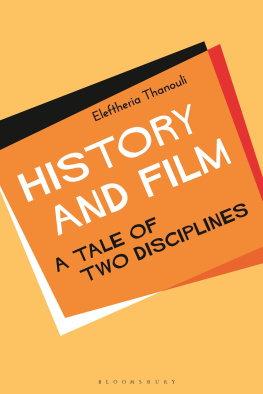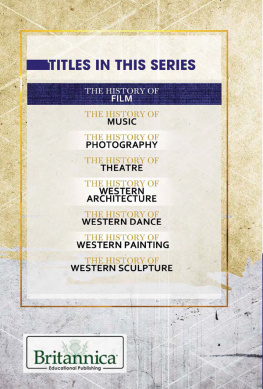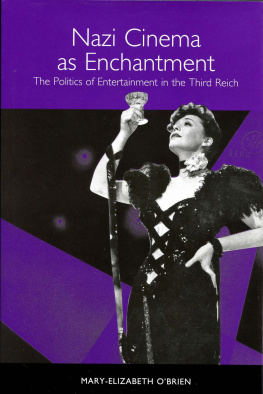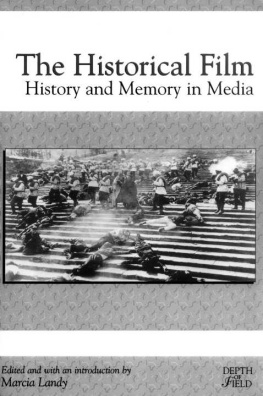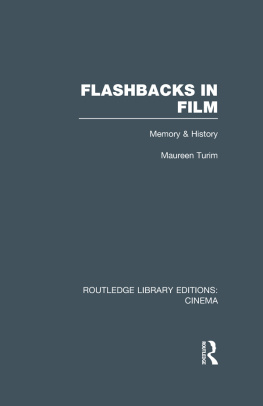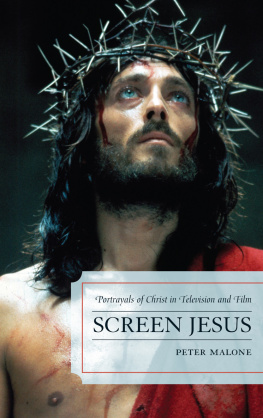
History and Film
To Thomas Elsaesser

Contents
I dedicate this book to Thomas Elsaesser because his writings enabled me to engage with the topic of representation, a topic that I had deliberately avoided for years, being a formalist, and all. History is an interest I owe to my husband Achilleas. He has a Contextualist philosophy in the way he practices medicine and a Reconstructionist appetite in the way he devours history books, both of which helped me develop an approach that could address complexity without sliding into relativism. Creative contradictions, is what Elsaesser once said that define me, and I have learned to live and be inspired by them.
This book was written over the course of two incredibly busy years during which I had to rely on the encouragement and support of many friends and colleagues. Betty Kaklamanidou and Yannis Tzioumakis fall into both categories, so their intellectual input, their patience and their faith in this project were life-saving. I would also like to thank Dudley Andrew who was one of the first people who read my book proposal and enthusiastically supported it. The same goes for Vrasidas Karalis, who is always there to offer brilliant advice. Many thanks go to Panagiotis Thanassas, Warren Buckland, Paris Mouratidis, and Stamatis Valasiadis who contributed to my writing at various phases. Antonis Daglidis, my talented colleague from the scenography division, stepped in to help with the cover at a moments notice. Katie Gallof, of course, was a gracious and generous editor, as always. My special thanks goes to my talented student George Dimoglou who assisted me with many technicalities.
I would like to make a particular mention of Robert Rosentones review of a part of the manuscript during the final stages. Those two pages instantly bring tears to my eyes every time I read them. They gave me great strength to see the whole thing through in a way that leaves me satisfied.
Finally, I have to thank my mom and our friend Manoussaki for standing by me all the time in every way possible. Of course, I am forever grateful to my two kids, Anastasia and George, for being so gifted and mature. They and the book benefitted immensely from, what Elsaesser would call, their antagonistic mutuality.
Historical books and historical films are two forms of historical thinking that have a lot more in common than people tend to think. As objects of study, the former are analyzed by historians and theorists of historiography, while the latter are mostly examined by film theorists with a particular interest in the representation of history on the screen. The gap that divides these two branches of scholarship is abysmal. For the vast majority of practicing historians, a historical film is a work of art, a figment of someones imagination. To argue that Schindlers List has fundamental formal and conceptual similarities with any written account of the Holocaust would be considered ludicrous, if not blasphemous. Film scholars, on the other hand, appreciate historical films for their cultural contribution to our society and for familiarizing a wide audience with important and often neglected moments in history but they would equally hesitate to base the value of cinematic history on its similarities with written history.
In this book, I attempt to renegotiate the dividing lines between written and filmic historical accounts by launching an extensive investigation into the historical, philosophical, formal, and institutional parameters that regulate them as generators of historical knowledge. I strive to illustrate that the dominant views on cinemas inability to match the accuracy and objectivity of academic history are derivative of a very specific epistemic context that was born in the nineteenth century and continues to cast its shadow to this day. I believe it is time to look back and carefully trace all those conventions that have convincingly passed for objective truth for so long. In fact, the more we historicize the concept of history the more we are likely to welcome historical films as meaningful representations of the past that form a symbiotic relation with written histories. In this light, historical films should not be valued for their supposedly unique ways of resurrecting the past but for the fascinating similarities they share with their written counterparts.
The tale of history and film that I begin in the following pages is not going to be one of fierce antagonism and hostility but one of intricate interactions, unexpected exchanges and ironic mirrorings between two different forms of history. Ultimately, I argue that what is more ironic is how history on film positions us in an exceptional vantage point for observing all the ways in which representing the past whether in spoken words, written elements or moving images is tied to very specific mechanisms for handling knowledge and power in a given society.
For most historians films are first and foremost artifacts, human-made objects for particular human use much like the many other objects with which man fills his environment.
Susman (1985, 26)
The term role of the film as an interpreter. As he writes:
[] the filmmaker, simply because he operates directly in terms of the actual manipulation of time and space, because in his editing he makes arrangements of time and space that shatter simple chronology, the traditional unities of time and space act as an historian faced with the same problem of finding the proper arrangement of materials to provide a view of the process that is his history.
Ibid.
In this passage, Susman compares the filmmaker to the historian and traces significant similarities in the way they both handle and manipulate time and space in order to properly arrange their material and construct their stories. Yet, this point of convergence, or this structural similarity in Jennifer E. Smyths words, between filmed and written history was not picked up by the researchers who followed in Susmans lead (Smyth 2006, 18). Neither was the oblique argument that every historian merely offers his own version of history. Instead, the focus switched to the material differences between cinematic images and written texts, taking for granted what written history is and exploring what visual history is not but might be. In his collection Image as Artifact: The Historical Analysis of Film and Television (1990), John OConnor resonates with Susmans work not only in the title but also in the quadruple division that he suggests for the study of history on the screen, big or small. OConnors schema includes the following four frameworks: first, the moving image as representation of history; second, the moving image as evidence for social and cultural history; third, actuality footage as evidence for historical fact, and fourth, the history of the moving image as industry and art form. Evidently, the role of representation is amplified here, whether it involves historical themes or not, while a more institutional approach to cinema and television as industries and art forms seems to combine what Susman had earlier described as a product and agent of history. Most importantly, what Susman and OConnor share is their appreciation of the visual media and their effort to protect them from the criticism and the intellectual disdain of the majority of the professional historians. By carving out a legitimate scholarly area of research and by lining up key questions and concerns, they laid the foundations for the serious consideration of film and televisions contribution to historical knowledge.
Next page
